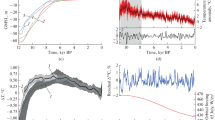Summary
From the conservation of the mass of the earth including the hydrosphere it can be concluded that continental growth has been connected with subcrustal flow from the ocean toward the continents. Calculations show that the volume of ocean bottom subsidence nearly equals to the volume of the uplifted continental masses above the level of the primeval ocean bottom. The sea level has not changed appreciably since Precambrian. Change of ocean bottom topography and emergence of continents do not effect global sea level. Transgression and regression are figurative terms and really indicate subsidence resp. uplift of the continental crust blocks around the shoreline.
Similar content being viewed by others
References
T. Boldizsár,Terrestrial Heat and Geothermal Resources in Hungary, Bull. VolcanologiqueXXX (1967), 221–227.
T. Boldizsár,Geothermal data from the Vienna basin, J. Geoph. Research73 (1968), 613–624.
J. Brocas andE. Picciotto,Nickel Content of Antarctic Snow: Implications of the Influx Rate of Extraterrestrial Dust, J. Geophys. Res.72 (1967), 2229–2236.
H. W. Menard andS. M. Smith,Hypsometry of Ocean Basin Provinces, J. Geoph. Research71 (1966), 4305–4325.
Author information
Authors and Affiliations
Rights and permissions
About this article
Cite this article
Boldizsár, T. Oceanic subcrustal flow toward the continents and constancy of global sea-level. PAGEOPH 72, 117–122 (1969). https://doi.org/10.1007/BF00875698
Received:
Issue Date:
DOI: https://doi.org/10.1007/BF00875698




